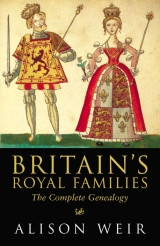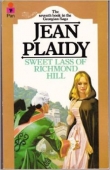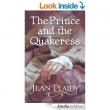
Текст книги "Britain's Royal Families"
Автор книги: Элисон Уир
Жанр:
Историческая проза
сообщить о нарушении
Текущая страница: 7 (всего у книги 21 страниц)
2 Mary; she married Ralph Neville of Westmorland.
Joan married secondly Ralph Neville, 1st Earl of Westmorland (1364?–1425), before 29 November, 1396, and had issue:
3 Richard, Earl of Salisbury (1400?–killed 1460); he married Alice (1406–1462), daughter of Thomas de Montacute, 4th Earl of Salisbury, and had issue, including Richard Neville,
Earl of Warwick, father of Anne, Queen of Richard III, and Isabella, Duchess of Clarence (under Edward IV,

see here
).
4 William, Baron Fauconberg, Earl of Kent (
d
.1463); he married Joan, Baroness Fauconberg (1406–1490), and had issue.
5 George, Baron Latimer (
d.
1469) (?); he married Elizabeth (1417–1480), daughter of Richard Beauchamp, Earl of Warwick, and had issue.
6 Robert, Bishop of Salisbury and Durham (1404?–1457).
7 Edward, Baron Bergavenny (
d
.1476); he married Elizabeth (
d.
1448), daughter of Richard Beauchamp, Earl of Worcester, and had issue. He married secondly Katherine (
d
. after 1478), daughter of Sir Robert Howard, and had issue.
8 Cuthbert (
d
. young).
9 Thomas (
d
. young).
10 Henry (
d
. young).
11 Katherine (
d
. after 1483); she married firstly John Mowbray, Duke of Norfolk (1392–1432), and had issue. She married secondly Thomas Strangeways. She married thirdly John, Viscount Beaumont (killed 1460). She married fourthly John Woodville (1445?–executed 1469), brother of Elizabeth, wife of Edward IV (under Henry IV,

see here
).
12 Joan; a nun.
13 Anne (
d.
1480); she married firstly Humphrey, Earl of Stafford (1402-killed 1460), and had issue. She married secondly Walter Blount, 1st Baron Mountjoy (1420?–1474).
14 Eleanor (
d
.1472); she married firstly Richard le Despenser, Baron Burghersh (1396–1414), and had issue. She married secondly Henry Percy, 2nd Earl of Northumberland (1392–killed 1455), and had issue.
15 Cecily, Duchess of York (under Edward IV,

see here
.
16 One other, unnamed in the records.
Joan was made a Lady of the Garter in 1399. She died on 13 November, 1440 at Howden, Yorkshire, and was buried in
Lincoln Cathedral.
7 Edmund
He was born on 5 June, 1341, at Abbot’s Langley (now King’s Langley), Herts. He was made a Knight of the Garter in c.April, 1361, and was created Earl of Cambridge on 13 November, 1362. He was created Duke of York on 6 August, 1385. He died on 1 August, 1402, at King’s Langley, Herts., and was buried there in the Church of the Mendicant Friars.
Edmund married firstly, between 1 January and 30 April, 1372, at Hertford Castle (?):
Isabella
She was the daughter of Peter I ‘the Cruel’, King of Castile, by Maria, daughter of John Garcias de Padilla, a handfast wife, and she was sister to Constance, wife of John of Gaunt (  see here). Isabella was born in c.1355/6 at Morales or at Tordesillas, Castile. She was made a Lady of the Garter in 1379. She died on 23 November, 1392/3, and was buried in the Church of the Dominican Friars, King’s Langley, Herts.
see here). Isabella was born in c.1355/6 at Morales or at Tordesillas, Castile. She was made a Lady of the Garter in 1379. She died on 23 November, 1392/3, and was buried in the Church of the Dominican Friars, King’s Langley, Herts.
Issue of marriage:
(i)
Edward
He was born in
c.
1373, perhaps at Norwich, Norfolk. He was made a Knight of the Garter in 1387. He was created Earl of Cork between 25 February, 1390, and 15 January, 1395, and Earl of Rutland on 25 February, 1390. He was created Duke of Aumale on 29 September, 1397, but deprived of the dukedom on 3 November, 1399. He succeeded his father as Duke of York on 1 August, 1402, and was confirmed in this dukedom on 5 November, 1402. He was restored to the dukedom of Aumale on 1 May, 1414. He was killed on 25 October, 1415, at the Battle of Agincourt, France, and was buried in the Collegiate Church of Fotheringhay, Northants.
Edward married, between 27 February, 1396, and 7 October, 1398:
Philippa
She was the daughter of John de Mohun, 2nd Baron of Dunster, by Joan, daughter of Sir Bartholemew de Burghersh of Ewyas Lacy, Co. Hereford. She married firstly Walter, 4th Baron FitzWalter (
d
.1386), before 27 June, 1385, and had issue:
1 Walter (
d
.1432); a knight; he married a lady called Elizabeth, and had issue.
Philippa married secondly Sir John Golafre of Langley, Oxon. (
d.
1396), before 13 November, 1389. She was made a Lady of the Garter in 1390. She died on 17 July, 1431, at Carisbrooke Castle, Isle of Wight, and was buried in Westminster Abbey.
(ii)
Constance
She was born in
c
.1374. She married Thomas le Despenser, 1st Earl of Gloucester (1373–executed 1400), between 16 April, 1378 and 7 November, 1389 (possibly later, but certainly before 14 January, 1394), and had issue:
1 Edward (
d.
young).
2 Richard, Baron Burghersh (1396–1414); he married Eleanor (
d
.1472), daughter of Ralph Neville, 1st Earl of Westmorland by Joan Beaufort, daughter of John of Gaunt, Duke of Lancaster (

above).
3 Hugh (
d
. young, 1401).
4 Elizabeth (
b.c
.1398;
d.
young).
5 Isabella (1400–1439); she married firstly Richard de Beauchamp, Earl of Worcester (1397–1422), and had issue, and secondly Richard de Beauchamp, Earl of Warwick (1382–1439), and had issue.
Constance was made a Lady of the Garter in 1386. She died on 28 November, 1416, and was buried in Reading Abbey, Berkshire.
Constance may have had the following
illegitimate issue
(although the daughter in question always held that her parents had married in
c
.1404; however, this claim failed against the petition of her father’s sisters):
By Edmund Holland, Earl of Kent (1383–1408):
1 Eleanor (?) (
b.
1406?); she married James Touchet, Baron Audley (1398?–1459), and had issue. She may have been the illegitimate issue of Edmund Holland by Elizabeth Burghersh, but this is unlikely.
(iii)
Richard
He was born in
c
.September,
c.
1375/6, at Conisburgh Castle, Yorkshire. He was recognised as hereditary Earl of Cambridge on 1 May, 1414, but forfeited all his honours and estates on 5
August, 1415, on which day he was executed for treason at Southampton Green, Hampshire. He was buried in the Chapel of God’s House, Southampton.
Richard married firstly, in
c.
May, 1406, or perhaps after 10 June, 1408 (date of dispensation) (although no record exists as to where):
Anne
She was the daughter of Roger Mortimer, Earl of March, by Eleanor Holland, and a great-great-granddaughter of Edward III (

above), and it was through her that the House of York derived its claim to the throne. She was born on 27 December, 1390, and died in September, 1411, perhaps in childbirth. She was buried in King’s Langley Church, Herts.
Issue of marriage:
(a)
Isabella
She was born in 1409. She married firstly Sir Thomas Grey of Werke or Heton (
d.
by 1443) after February, 1413, but the marriage was annulled before 1426. She married secondly Henry Bourchier, 1st Earl of Essex (
c
.1409–1483), before 25 April, 1426, and had issue:
1 William, Viscount Bourchier (either killed 1471 or
d.
1483?); he married Anne (1438?–1489), daughter of Richard Woodville, 1st Earl Rivers, and sister of Elizabeth, wife of Edward IV, and had issue.
2 Henry (
d
.1462); he married Elizabeth, Baroness Scales (
d
.1473), daughter of Thomas, Baron Scales.
3 Humphrey (killed 1471); he married Joan (
d
.1490), daughter of Sir Richard Stanhope of Rampton.
4 John (
d
.1485 or 1494); he married firstly Elizabeth, Baroness Ferrers de Ruthyn, and secondly a daughter, whose name is not known, of John Chichele.
5 Thomas (
d
.1492); he married Isabella Barre.
6 Edward (killed 1460).
7 Fulk (
d
. young).
8 Hugh (
d
. young).
9 Isabella (
d
. young).
10 Florence (
d
.1525/6).
Isabella died on 2 October, 1484, and was buried in
Beeleigh Abbey, Maldon, Essex; her remains were later removed to Little Easton Church, Essex.
(b)
Richard
He inherited the dukedom of York, and was the first of his line to adopt the surname Plantagenet. His laying claim to the throne of England led to the Wars of the Roses. For a full entry,

under Edward IV.
Richard married secondly, around 1411/15 (although no record exists as to where):
Matilda
She was the daughter of Thomas, 6th Baron Clifford, by Elizabeth, daughter of Thomas de Ros, Baron Ros of Hamlake. After the death of Richard, she married secondly (?) John Neville, 5th Baron Latimer of Danby (
d
.1430), from whom she was later divorced. She died on 26 August, 1446, and was buried in Roche Abbey, Yorkshire.
Edmund married secondly, before 4 November, 1393:
Joan
She was the daughter of Thomas Holland, 1st Earl of Kent, son of Joan, Princess of Wales (  see here), by Alice, daughter of Richard FitzAlan, Earl of Arundel, a descendant of Henry III. Her sister Margaret was married in turn to the sons of John of Gaunt (
see here), by Alice, daughter of Richard FitzAlan, Earl of Arundel, a descendant of Henry III. Her sister Margaret was married in turn to the sons of John of Gaunt (  see here) and Henry IV. Joan was born in c.1380. She was made a Lady of the Garter in 1399. After the death of Edmund, she married secondly William, 5th Baron Willoughby d’Eresby ( d.1409) before 9 August, 1404. She married thirdly Henry, 3rd Baron Scrope of Masham (executed 1415), on 6 September, 1410, at Faxflete Chapel, Yorkshire, and had issue, although no details are available. She married fourthly Henry Bromflete, 1st Baron de Vesci ( d.1469), between Michaelmas, 1415 and 27 April, 1416. Joan died on 12 April, 1434.
see here) and Henry IV. Joan was born in c.1380. She was made a Lady of the Garter in 1399. After the death of Edmund, she married secondly William, 5th Baron Willoughby d’Eresby ( d.1409) before 9 August, 1404. She married thirdly Henry, 3rd Baron Scrope of Masham (executed 1415), on 6 September, 1410, at Faxflete Chapel, Yorkshire, and had issue, although no details are available. She married fourthly Henry Bromflete, 1st Baron de Vesci ( d.1469), between Michaelmas, 1415 and 27 April, 1416. Joan died on 12 April, 1434.
8 Blanche
She was born in March, 1342, in the Tower of London, and died there the same month. Hence she was known as Blanche de la Tour. She was buried in Westminster Abbey.
9 Mary
She was born on 10 October, 1344, at Waltham, near Winchester, Hants. She married John de Montfort IV, Duke of Brittany (1339–1399), in the summer of 1361 at Woodstock Palace, Oxon. She died in the winter of 1361/2, and was buried in Abingdon Abbey, Oxon.
10 Margaret
She was born on 20 July, 1346, at Windsor Castle. She married John Hastings, 2nd Earl of Pembroke (1347–1375), on 19 May, 1359, at Reading Abbey, Berkshire. She died after 1 October, 1361, and was buried in Abingdon Abbey, Oxon.
11 Thomas
He was born probably in the summer of 1347, at Windsor Castle, and died young in 1348 (?). He was buried in King’s Langley Church, Herts. Thomas has been overlooked by many historians who have confused him with his two brothers called William and his youngest brother, also called Thomas.
12 William
He was born before 24 June, 1348, at Windsor Castle, and died before 5 September, 1348. He was buried in Westminster Abbey.
13 Thomas
He was born on 7 January, 1355, at Woodstock Palace, Oxon. He was created Earl of Buckingham on 16 July, 1377, and became Earl of Essex in right of his wife on 22 June, 1380. He was made a Knight of the Garter between April, 1380, and April, 1381. He was called Duke of Aumale from before 3 September, 1385, although no record exists of his formal creation as such. He was created Duke of Gloucester on 6 August, 1385. He was murdered, probably on the orders of Richard II, at the Prince’s Inn, Calais, France, on 8/9 September, 1397, and was buried in the Collegiate Church of the Holy Trinity, Pleshy, Essex; his remains were later removed to Westminster Abbey.
Thomas married, before 8 February, 1376, perhaps in 1374 (?) (although no record exists as to where):
Eleanor
She was the daughter of Humphrey de Bohun, Earl of Hereford, Essex and Northampton, by Joan, daughter of Richard FitzAlan, Earl of Arundel, a descendant of Henry III, and she was born in c.1366. She was made a Lady of the Garter in 1384. After her husband’s murder in 1397, she is said to have lived as a nun at Barking Abbey, Essex, but she did not renounce her property. She died on 3 October, 1399, at the Minoresses’ Convent in Aldgate, London, and was buried in Westminster Abbey.
Issue of marriage:
(i)
Humphrey
He was born in
c.
April, 1381/2, and styled Earl of Buckingham from his birth until his father’s murder on 9 September, 1397. He died on 2 September, 1399, either at Chester, or Coventry, or Anglesey, of plague, and was buried in Walden Abbey, Essex.
(ii)
Anne
She was born in April, 1383. She married firstly Thomas, 3rd Earl of Stafford (1368?–1392), in
c.
1390. She married secondly Edmund, 5th Earl of Stafford (1377–1403: killed at the Battle of Shrewsbury), before 28 June, 1398, and had issue:
1 Anne; she married Edmund Mortimer, Earl of March and Ulster (

see here
).
2 Humphrey, Earl of Stafford (1402–1460: killed at the Battle of Wakefield); he married Anne (
d.
1480), daughter of Ralph Neville, 1st Earl of Westmorland by Joan Beaufort (

see here
), and had issue.
3 Philippa (
d.
young).
Anne was recognised as Countess of Buckingham, Hereford and Northampton, and Lady of Brecknock and Holderness from 1399, and was so styled from that date. She also styled herself Countess of Stafford. She was made a Lady of the Garter in 1405. She married thirdly William Bourchier, Count of Eu (
d.
1420), before 20 November, 1405, and had issue:
4 Henry, Viscount Bourchier, Count of Eu, 1st Earl of Essex (
c.
1409–1483); he married Isabella Plantagenet (

see here
), and had issue.
5 Thomas, Cardinal of St Cirac, Archbishop of Canterbury (1413–1486).
6 William, Baron FitzWaryn (
c
.1412–before 1469); he married Thomasine Hankeford, Baroness FitzWaryn (1423–1453), daughter of Sir Richard Hankeford, and had issue. He married secondly Katherine (
d.
1467), daughter of John Affeton of Afton, Devon.
7 John, Baron Berners (
c
.1415–1474); he married Marjorie, daughter of Richard, Baron Berners, and had issue.
8 Eleanor (
c.
1417–1474); she married John Mowbray, Duke of Norfolk (1415–1461), and had issue.
Anne died between 16 and 24 October, 1438, and was buried in Llanthony Priory, Monmouthshire.
(iii)
Joan
She was born in 1384. She perhaps married (or was betrothed to) Gilbert Talbot, Baron Talbot of Goderick Castle and Blackmere (
d.
1419), but there was no issue of the marriage.
Joan died on 16 August, 1400, perhaps in childbirth, and was buried in Walden Abbey, Essex.
(iv)
Isabella
She was born on 12 March, 1385/6, and became a nun at the Minoresses’ Convent in Aldgate, London, on 23 April, 1399. She died in
c.
April, 1402.
(v)
Philippa
She was born in
c.
1389, and died before 3 October, 1399.
Edward III also had the following illegitimate issue:
By Alice Perrers (1348?–1400), wife of William de Windsor:
1 John de Southeray or Surrey ( c.1364/5–after 1383:1384?); knighted 1377; he married Matilda, called a sister of Lord Henry Percy.
2 Joan; she married Robert Skerne of Kingston-upon-Thames, and perhaps had issue.
3 Joan or Jane; she married Richard Northland.
Perhaps by an unknown mother:
4 Nicholas Lytlington (?), Abbot of Westminster ( d.1386). He did not claim to be the King’s son, and was probably a member of the Despenser family.
EDWARD III
He died on 21 June, 1377, at Sheen Palace, Surrey, of a stroke, and was buried in Westminster Abbey.
He was succeeded by his grandson Richard.

Richard II
FATHER: Edward, Prince of Wales(under Edward III,  see here).
see here).
MOTHER: Joan of Kent(under Edward III,  see here).
see here).
SIBLINGS: (under Edward III,  see here).
see here).
RICHARD II
He was born on c.6 January, 1367 (or 1366?), at Bordeaux, Gascony, France. He was created Prince of Wales, Earl of Cornwall and Earl of Chester on 20 November, 1376, and made a Knight of the Garter on 23 April, 1377. He succeeded his grandfather Edward III as King of England on 22 June, 1377, and was crowned at Westminster Abbey on 16 July, 1377.
Richard II was deposed on 19 August, 1399, by Henry of Bolingbroke, who usurped the throne as Henry IV when Richard formally abdicated on 29 September, 1399.
Richard II married firstly, on 14, 20 or 22 January, 1382, at St Stephen’s Chapel in the Palace of Westminster:
Anne
She was the daughter of Charles IV, Holy Roman Emperor, by Elizabeth, daughter of Bogislaw V, Duke of Pomerania. Anne of Bohemia, as she was known, was born on 11 May, 1366, at Prague, Bohemia. She was crowned on 22 January, 1382, at Westminster Abbey, and was made a Lady of the Garter that same year. She died on 7 June, 1394, at Sheen Palace, Surrey, of the plague, and was buried in Westminster Abbey. There was no issue of the marriage.
Richard II married secondly, probably on 4 (less probably, 1) November, 1396, at St Nicholas’ Church, Calais, France:
Isabella
She was the daughter of Charles VI, King of France, by Isabella, daughter of Stephen II, Duke of Bavaria-Ingolstadt. Her sister Katherine later married Henry V. Isabella was born on 9 November, 1389, at the Palace of the Louvre in Paris. She was made a Lady of the Garter in 1396, and was crowned on 5, 7 or 8 January, 1397, at Westminster Abbey. After the death of Richard II, she married secondly Charles of Valois, Duke of Orleans (1394–1465), on 29 June, 1406, at Compiégne, France, and had issue:
1 Joan (1409–1432); she married John II, Duke of Alençon (1409–1476), and had issue.
Isabella died on 13 September, 1409, at the Château of Blois, France, in childbirth, and was buried in St Laumer’s Abbey, Blois. Her remains were later removed to the Church of the Celestines, Paris. There was no issue of her marriage to Richard due to her extreme youth.
Richard II is said to have had the following illegitimate issue:, but this is unlikely on chronological grounds:
1 Richard Maudelyn.
RICHARD II
He was probably murdered by being starved to death early in February, 1400, whilst being held prisoner in Pontefract Castle, Yorkshire; he was certainly dead by 17 February. He was buried in King’s Langley Church, Herts., but was removed to Westminster Abbey in 1413.
He was succeeded by his cousin Henry of Bolingbroke.
CHAPTER FOUR
The Later Plantagenets: The Houses of Lancaster and York
The prolific Edward III sired eight sons, four of whom grew to maturity and had sons of their own. The eldest was the Prince of Wales, that Edward known to history as the Black Prince, who was the father of Richard II. Richard, although his entitlement to the throne was without dispute, was nevertheless a weak and unstable ruler. This led to his deposition by Henry of Bolingbroke in 1399, Bolingbroke’s usurpation of the throne, and Richard’s own probable murder the following year.
Bolingbroke, henceforth known as Henry IV, was the son of John of Gaunt, Duke of Lancaster, third surviving son of Edward III. In 1399, when Bolingbroke staged his successful coup, the rightful heir to the throne of England was Edmund Mortimer, Earl of March and Ulster, a child of nearly eight. Edmund was the great-grandson of Lionel of Antwerp, Duke of Clarence, second son of Edward III. Lionel’s only child had been a daughter, Philippa, who was Edmund’s grandmother, but in England there was no Salic Law to prevent the crown passing by way of inheritance to or through a female, and there is no doubt that Edmund had a better claim to the throne than Bolingbroke. However, Edmund was a child and Bolingbroke a grown man and a proven soldier: England needed a firm ruler, and so the claim of Edmund Mortimer was set aside while the House of Lancaster usurped the throne. Edmund died in 1425, and his claim to the throne was inherited by his surviving sister Anne’s child, Richard, Duke of York. It was he who first used the surname Plantagenet.
For half a century, the House of Lancaster ruled England under Henry IV, Henry V, and Henry VI. Henry V executed Richard, Earl of Cambridge, who was the husband of Anne Mortimer and the son of Edmund of Langley, Duke of York, fourth surviving son of Edward III; Richard of Cambridge had plotted to overthrow the fifth Henry, but his treason was discovered and he was eliminated on the eve of the campaign that would see the English victorious at Agincourt. Henry V died young, and the House of Lancaster came to grief under his son Henry VI, who was fitted rather for the clerical life than for kingship. Henry VI married the energetic and passionate Margaret of Anjou, but the marriage was childless for eight years. Then, in 1453, the queen produced a son whilst her husband was suffering one of his periodic fits of insanity, which Margaret’s enemies interpreted as an admission that the Queen had foisted a bastard upon the royal line. Nevertheless, the infant was created Prince of Wales the following year. However, it was Henry VI’s ineptitude as a ruler, rather than the rumours about his son’s paternity, that precipitated the dynastic struggle that later came to be known as the Wars of the Roses, after the emblems of the two warring factions: the red rose of Lancaster, and the white rose of York.
York deeply resented the court party headed by the Queen, and promoted himself as the champion of good government; only later did he assert his superior claim to the throne. Thirty years of intermittent strife followed the outbreak of hostilities in 1455. Early battles in the conflict were indecisive. Then, in 1460, York was killed at the Battle of Wakefield, and his cause taken up by his son, Edward, Earl of March, who won a decisive victory at Towton the following Spring. This led to him being accepted as King of England and crowned at Westminster Abbey. Henry VI went into hiding, but was later taken into custody and imprisoned in the Tower.
Edward IV was a strong king, but he made the fatal mistake of making a very unpopular marriage to a commoner called Elizabeth Wydville, who brought instead of a dowry a host of rapacious relatives, eager for lands, honours and wealth. This marriage alienated the great Earl of Warwick, known as ‘the kingmaker’, who had been Edward’s staunchest supporter. Warwick allied himself with Margaret of Anjou and brought about the ‘readeption’ of Henry VI, while Edward fled to the Low Countries. But he soon returned with an army, to march for the final time upon his enemies. Warwick was killed at the Battle of Barnet in April, 1471, and Margaret’s Lancastrian forces routed in the bloody Battle of Tewkesbury in May. On 21 May, Henry VI died in mysterious circumstances in the Tower of London. At last, the House of York was securely established upon the throne.
Edward IV died in 1483, worn out prematurely by the pleasures of the table and the bedchamber, leaving as his heir Edward V, a boy of twelve. The government of the realm was placed in the capable yet treacherous hands of Edward IV’s brother, Richard, Duke of Gloucester. After securing the persons of Edward V and his brother Richard, Duke of York, in the Tower of London, and eliminating his enemies one by one, Gloucester had it announced, on the basis of questionable evidence, that his brother’s marriage to Elizabeth Wydville had been bigamous, and that their children were therefore bastards and unfit to inherit the throne. As a result, the crown was offered to Gloucester, who was crowned King Richard III in July, 1483. Edward V and his brother, the ‘Princes in the Tower’, were never seen alive again, and controversy has raged ever since as to their fate. The evidence strongly suggests that they were murdered on the orders of Richard III, although this has often been disputed.
Richard III did not long enjoy his crown. His son died in 1484, and his wife in 1485. His heir was his sister’s son, John de la Pole, Earl of Lincoln. Yet England was never destined to have a King John II. For although the great families who were descended from Edward III and had a strong claim to the throne of England had either died out or been barred from the succession by Act of Attainder, there yet remained in exile in France a scion of the Beauforts, who were the issue of John of Gaunt by his mistress (and later wife) Katherine Swynford. After their parents’ marriage in 1396, the Beauforts were declared legitimate by a Statute of Richard II, but Henry IV added an amendment barring them from the throne, which was of dubious legality. This minor technicality did not, however, deter the ‘unknown Welshman’ called Henry Tudor, who in 1485 invaded England with a foreign army, defeated Richard III at the Battle of Bosworth, and had himself crowned on the battlefield as King Henry VII with the circlet that had fallen from the head of the last Plantagenet King of England and rolled under a hawthorn bush near to where Richard fell, hacked to death in the midst of the fray.
Thus was the Tudor dynasty founded, of whom we shall hear more in the next chapter. Henry VII united the rival Houses of York and Lancaster by marrying Elizabeth, daughter of Edward IV. The Wars of the Roses ended in 1487 with the Battle of Stoke, when John, Earl of Lincoln, Richard III’s nephew and heir, perished. But the tragedy of the House of York would be drawn out for a further eighty years, during which time its surviving members were either brutally eliminated or neutralised by the usurping, ever-suspicious Tudors.








